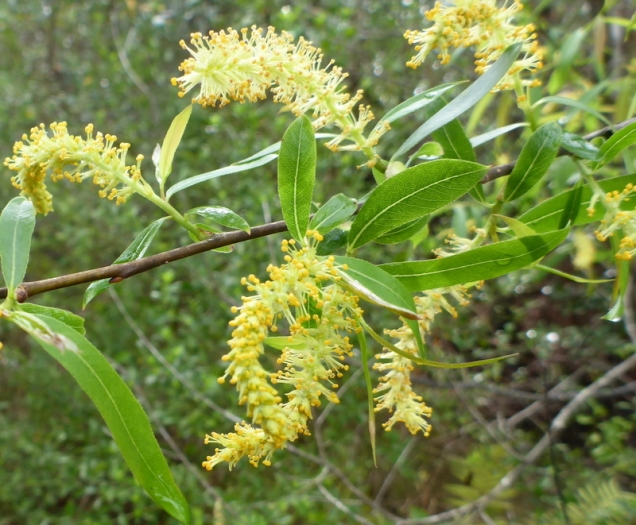Coastal Plain Willow
(Salix caroliniana)
Coastal Plain Willow (Salix caroliniana)
/
/

mfeaver
CC BY 4.0
Image By:
mfeaver
Recorded By:
Copyright:
CC BY 4.0
Copyright Notice:
Photo by: mfeaver | License Type: CC BY 4.0 | License URL: http://creativecommons.org/licenses/by/4.0/ | Rights Holder: mfeaver | Publisher: iNaturalist | Date Created: 2019-02-28T10:45:49-08:00 |



















































Estimated Native Range
Summary
Salix caroliniana, commonly known as Coastal Plain Willow, is a deciduous tree native to wetland areas, stream banks, and marsh edges in the Southeastern United States. It typically grows to a height of 20-30 feet (6-9 meters) and a width of 10-18 feet (3-5.5 meters). The tree has a slender, upright form with light green leaves and yellow catkins that appear in early spring before the leaves, providing early-season interest. The bark is smooth and gray, becoming furrowed with age. Coastal Plain Willow is valued for its rapid growth and adaptability to wet conditions, making it useful for erosion control and riparian plantings.
This species thrives in full sun to part shade and requires high amounts of water, reflecting its natural affinity for moist environments. It is tolerant of a range of soil types, including those with slow, medium, or fast drainage. Coastal Plain Willow is often used in naturalized plantings, as a quick-growing screen, and for stabilizing stream banks. It is also a host plant for several butterfly species, adding to its ecological value. However, it can be susceptible to pests and diseases such as willow scab and canker, and its aggressive root system may cause problems if planted too close to infrastructure.CC BY-SA 4.0
This species thrives in full sun to part shade and requires high amounts of water, reflecting its natural affinity for moist environments. It is tolerant of a range of soil types, including those with slow, medium, or fast drainage. Coastal Plain Willow is often used in naturalized plantings, as a quick-growing screen, and for stabilizing stream banks. It is also a host plant for several butterfly species, adding to its ecological value. However, it can be susceptible to pests and diseases such as willow scab and canker, and its aggressive root system may cause problems if planted too close to infrastructure.CC BY-SA 4.0
Plant Description
- Plant Type: Tree
- Height: 20-30 feet
- Width: 10-18 feet
- Growth Rate: Rapid
- Flower Color: N/A
- Flowering Season: Spring
- Leaf Retention: Deciduous
Growth Requirements
- Sun: Full Sun, Part Shade
- Water: High
- Drainage: Fast, Medium, Slow
Common Uses
Bee Garden, Bird Garden, Butterfly Garden, Deer Resistant, Low Maintenance, Salt Tolerant, Water Garden
Natural Habitat
Wetland areas, stream banks, and marsh edges in the Southeastern United States
Other Names
Common Names: Carolina Willow
Scientific Names: , Salix caroliniana, Salix nigra var. venulosa, Salix wardii, Salix occidentalis, Salix nigra var. wardii, Salix longipes var. wardii, Salix longipes, Salix harbisonii, Salix amphibia
GBIF Accepted Name: Salix caroliniana Michx.